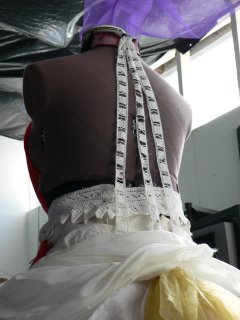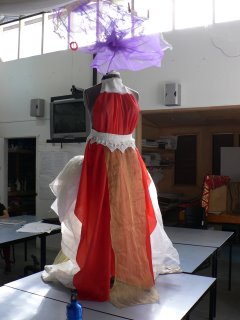
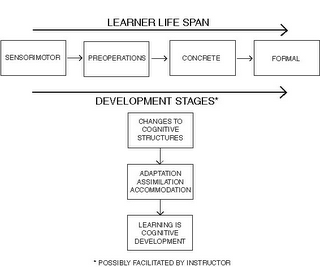
PIAGET
Piaget identified four stages of learning, which he believed where ‘universal (that is, they apply to everyone);…and that they are invariant (that is, unchanging), meaning that the order in which children pass through the stages can not be varied.’(From the ‘Education Phycology-Krause, Bochner and Duchesne 2003)
1 Sensorimotor: (birth to about age 2)
2 Preoperational: (begins about the time the child starts to talk to about age 7)
3 Concrete: (about first grade to early adolescence)
4 Formal Operations: (adolescence)
http://honolulu.hawaii.edu/intranet/committees/FacDevCom/guidebk/teachtip/piaget.htm
After reading Piagets theories one can appreciate the insight this man had by reflecting on ones own experiences of learning and teaching. Like most theorist there are the both the strengths and limitations, the ‘fors’ and ‘againsts” that could be discussed at great length but I would like to look at the relevant factors that promote higher learning in ICT in education.
Piaget ‘emphasised the importance of active problem solving’, a well-constructed Webquest can be an effective way for students to learn concepts by inquiry and problem solving, with the aid of the Internet and other resources. Webquests are a clever way to help educators filter the great expanse of the Internet into bite size chunks that can be evaluated for their relevance and quality. “Webquests are inquiry activities that present students with a challenging task, provide access to a range of resources (most often accessed through the Internet) and scaffold the learning process to promote higher order thinking.”(March, 2001) [From the ‘Educational Phycology-Krause, Bochner and Duchesne 2003])
Piaget ‘was particularly interested in peer interaction as a means for children to expand their ideas, to overcome conflicts and achieve shared solutions that are more mature than individual efforts (Brown, Metz and Campione, 1996 [From the ‘Educational Phycology-Krause, Bochner and Duchesne 2003]))
I have seen this theory realised through my observations of a Year 8 (14 year old) digital media/ film/ art class especially the male students. Year 8 at the best of times are hard to keep quite let alone focused, interested and committed. But through the use of programs such as I Movie, Final Cut Pro, Garage Band and PhotoShop in a art theory / art making class these students are producing articulate, postmodern, creative, innovative and stimulating work.
This Social Constructivist learning environment has “encouraged learner-centred experiences and activities”, “provided opportunities for learners to work together” and “assisted novice learning to develop expertise” thus achieving the deeper order learning that it is postulated ICT can facilitate.
Vygotsky

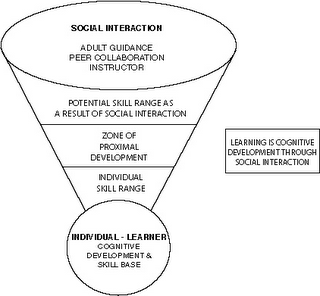
“One of the many advantages of computer-based learning resources is their capacity for facilitating individualised learning. This is evident in behaviourist-style drill-and-practice programs, but computers may also function as scaffolds that identify a learner’s ‘zone of proximal development’ and foster their cognitive development (Salomom, Perkins, and Globerson, 1991)
“ZDP- the distance between children’s current level of competence on a task and the level they can achieve with supporter guidance. [From the ‘Educational Phycology-Krause, Bochner and Duchesne 2003]
Vygotsky also stressed the “importance of social interaction in learning” [From the ‘Educational Phycology-Krause, Bochner and Duchesne 2003]
After reading Vygotskys theories I believe one of the important things he observed was that learning and development occurs within a ‘sociohistorical’ and ‘sociocultral’ context.
Taking that into consideration educators need to very aware of the way ICT is used within today’s society. As a teacher of teenagers they themselves are one of best benchmarks in discovering what is new, interesting and relevant to them in the ICT world. For most teenagers computers are an everyday reality through which they express themselves. They are not afraid to use them, navigating their way rapidly through any new programs that they encounter. These children can be MSNing, Downloading songs, whilst writing a word document without even a second thought. Today’s students are multi-taskers of the highest order so to bring ICT in as an effective educational tool the teachers have to form well structured scaffolding and relevant, achievable outcomes within the lesson.
The Postmodern society is the ‘socio-historical context’ in which we teach.
“Postmodernism is away of thinking which suggests that everything can be explained and interpreted in a number of different ways due to the changing nature of what is true and how we accept facts” (Revised HSC Visual Art in a month-Craig Malyon)
Postmodernism posses many question non more prevalent than ‘ownership’. In a world where copying information is as swift as a click of the mouse the issue of ownership becomes very blurred, especially when you look at it through the ideals of Postmodernism.
As an art movement Postmodernism revolves around the idea of appropriation, recontextualisation, and eclecticism deeply challenging traditional modes of thinking.
This is a ‘Brave new World’ in which we live where new rules have to be written to accommodate the rapidly morphing realm of Cyber Space. This becomes an issue when setting students tasks to research information, which these days will be done primarily on the Internet. First there is the question of the quality of the information with which they have easy access to through such search engines as ‘Google’ (a search engine that lists there websites by popularity [how many hits]). Then once the information is found there’s the quick copy, cut, paste method of creating a document, this is an easy and tempting road for some students and an even less productive method than copying straight from a book. At least the student will have had to read the information as it was copied which isn’t the case when using a computer.
Computers have many quick, effective and resourceful qualities as a cognitive tool but they have just as many negative ones and as an educator it’s best to find a balanced and enhancing way to integrate them into education.
“Vygotsky argued very strongly that the children and the environment interact to mould cognition in a culturally appropriate way” [From the ‘Educational Phycology-Krause, Bochner and Duchesne 2003]
Howard Garner

Howard Garner states in this article “Multiple Intelligences after twenty years” written in 2003 that MI (Multiple Intelligences) ‘should not in it’s self be an educational goal. Educational goals need to reflect one’s own values, and these can never come simply or directly from a scientific theory.’
http://pzweb.harvard.edu/PIs/HG_MI_after_20_years.pdf After reading this article I feel I have formed a better understanding of how Garners MI could be used to help formulate lessons.
The way in which instructions are given is a great example of how teachers could take in to consideration the different ‘intelligences’. A well formulated interactive website uses among other things text, graphics, photos, animation and video to instructed and inform the student of the task and information thus considering some of the intelligences.
Using this web site,
http://www.mitest.com/omitest.htm, teachers could test their classes to establish what intelligences the class is made up of, the teacher could also use observation of different class activities to form a even deeper understanding of this.
Bruner

Bruner like Vygotsky observed that knowledge was constructed not in isolation but in a ‘social context’. He was a structural theorist, who believed ‘knowledge is most effectively gained by personal discovery’ and that teachers would engage students in a ‘active dialogue’ and guide them when necessary so that students would progressively build their own knowledge base, rather than be ‘taught’.
In the year 8 film class of which I have already written about, I have observed these theories in practice. These students have been guided by film makers / teachers who have implemented the students personal discovery in the finer points of the art of film making.
By encouraging, supporting, and providing the scaffolding, the ‘hows’ in using the programs, the teachers have helped the students understand the cognitive tool and facilitated the possibility of higher order learning in the realm of ICT.
It is surely the case that schooling is only one small part of how a culture inducts the young into its canonical ways. Indeed, schooling may even be at odds with a cultu

re's other ways of inducting the young into the requirements of communal living.... What has become increasingly clear... is that education is not just about conventional school matters like curriculum or standards or testing. What we resolve to do in school only makes sense when considered in the broader context of what the society intends to accomplish through its educational investment in the young. How one conceives of education, we have finally come to recognize, is a function of how one conceives of culture and its aims, professed and otherwise. (Jerome S. Bruner 1996: ix-x)
For me this sums up the way in which all education should be considered. In an ideal world Education would be about the whole wellbeing of the a child who is living within a conscious community whose ideals and expectations are interconnected.
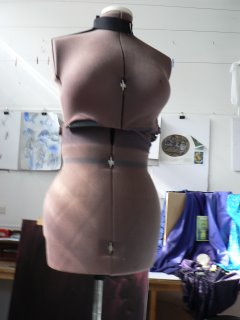
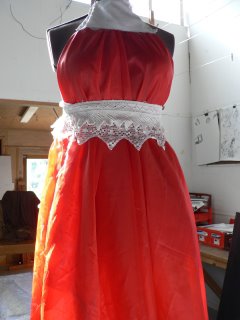
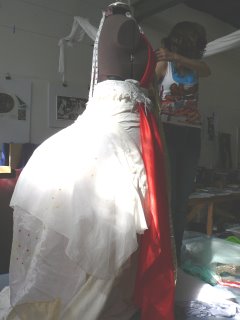 This was quite a constructivist lesson I had been reading a lot about constructivism so it was at the forefront of my mind.
This was quite a constructivist lesson I had been reading a lot about constructivism so it was at the forefront of my mind.
